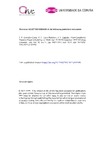Low-Complexity Distance-Based Scheduling for Multi-User XL-MIMO Systems

View/
Use this link to cite
http://hdl.handle.net/2183/35002Collections
- Investigación (FIC) [1678]
Metadata
Show full item recordTitle
Low-Complexity Distance-Based Scheduling for Multi-User XL-MIMO SystemsDate
2021-11Citation
J. P. Gonzalez-Coma, F. J. Lopez-Martinez, y L. Castedo, «Low-Complexity Distance-Based Scheduling for Multi-User XL-MIMO Systems», IEEE Wireless Commun. Lett., vol. 10, n.o 11, pp. 2407-2411, nov. 2021, doi: 10.1109/LWC.2021.3101940.
Abstract
[Abstract]: We introduce Distance-Based Scheduling (DBS), a new technique for user selection in downlink multi-user communications with extra-large (XL) antenna arrays. DBS categorizes users according to their equivalent distance to the antenna array. Such categorization effectively accounts for inter-user interference while largely reducing the computational burden. Results show that ( i ) DBS achieves the same performance as the reference zero-forcing beamforming scheme with a lower complexity; ( ii ) a simplified version of DBS achieves a similar performance when realistic spherical-wavefront (SW) propagation features are considered; ( iii ) SW propagation brings additional degrees of freedom, which allows for increasing the number of served users.
Keywords
Antenna arrays
Massive MIMO
Near-field
Precoding
XL-MIMO
Massive MIMO
Near-field
Precoding
XL-MIMO
Description
© 2021 IEEE. This version of the article has been accepted for publication, after peer review. Personal use of this material is permitted. Permission from IEEE must be obtained for all other uses, in any current or future media, including reprinting/republishing this material for advertising or promotional purposes, creating new collective works, for resale or redistribution to servers or lists, or reuse of any copyrighted component of this work in other works. The Version of Record is available online at: https://doi.org/10.1109//LWC.2021.3101940
Editor version
Rights
Copyright © 2021, IEEE
ISSN
2162-2337
2162-2345
2162-2345





